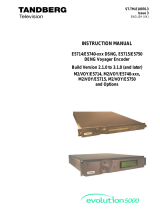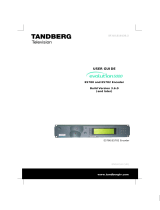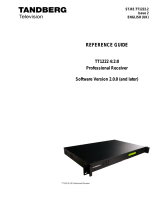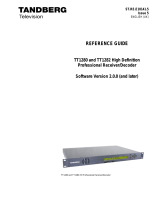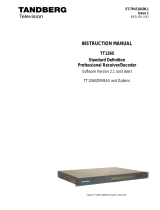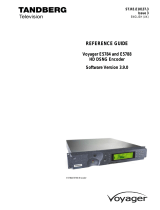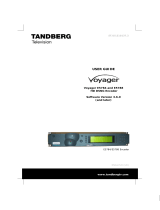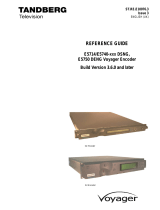Page is loading ...

ST.RE.E10135.4
Issue 4
ENGLISH (UK)
REFERENCE GUIDE
E5780 and E5782 Encoder
Build Version 3.11.0
(and later)
E5780/E5782 Encoder

Preliminary Pages
Page ii Reference Guide: evolution 5000 E5780 and E5782 Encoder
ST.RE.E10135.4
Issue 4 first published in 2007 by:
T
ANDBERG TELEVISION LTD
R
EGISTERED ADDRESS:
UNIT 2 STRATEGIC PARK, COMINES WAY,
H
EDGE END, SOUTHAMPTON,
HAMPSHIRE,
SO30 4DA
U
NITED KINGDOM
Registered Company Number 03695535
This document and the information contained in it is the
property of TANDBERG Television Ltd and may be the
subject of patents pending and granted. It must not be
used for commercial purposes nor copied, disclosed,
reproduced, stored in a retrieval system or transmitted
in any form or by any means (electronic, mechanical,
photocopying, recording or otherwise), whether in
whole or in part, without TANDBERG Television’s prior
written agreement.
2003-2007 TANDBERG Television Ltd. All rights reserved.
SVENSKA
LÄS DETTA FÖRST!
Om Ni inte förstår informationen i denna handbok
ARBETA DÅ INTE MED DENNA UTRUSTNING.
En översättning till detta språk av denna handbok kan också anskaffas,
på Er bekostnad.
ENGLISH (UK)
READ THIS FIRST!
If you do not understand the contents of this manual
DO NOT OPERATE THIS EQUIPMENT.
Also, translation into any EC official language of this manual can be
made available, at your cost.
ΕΛΛΗΝΙΚΑ
∆ΙΑΒΑΣΤΕ ΠΡΩΤΑ ΑΥΤΟ!
Αν δεν καταλάβετε το περιεχόµενο αυτού του βοηθήµατος/εγχειριδίου
ΜΗΝ ΛΕΙΤΟΥΡΓΗΣΕΤΕ ΑΥΤΟΝ ΤΟΝ ΕΞΟΠΛΙΣΜΟ.
Επίσης, αυτό το εγχειρίδιο είναι διαθέσιµο σε µετάφραση
σε αυτή τη γλώσσα και µπορείτε να το αγοράσετε.
DEUTSCH
LESEN SIE ZUERST DIESEN HINWEIS!
Sollte Ihnen der Inhalf dieses Handbuches nicht klar verständlich sein,
dann
BEDIENEN SIE DIESE GERÄTE NICHT!
Eine Übersetzung des Handbuches in diese Sprache ist gegen
Berechnun
g
lieferbar.
ESPAÑOL
LEA ESTE AVISO PRIMERO!
Si no entiende el contenido de este manual
NO OPERE ESTE EQUIPO.
Podemos asimismo suministrarle una traducción de este manual al
(idioma) previo pago de una cantidad adicional que deberá abonar
usted mismo.
FRANÇAIS
AVANT TOUT, LISEZ CE QUI SUIT!
Si vous ne comprenez pas les instructions contenues dans ce manuel
NE FAITES PAS FONCTIONNER CET APPAREIL.
En outre, nous pouvons vous proposer, à vos frais, une version
française de ce manuel.
ITALIANO
LEGGERE QUESTO AVVISO PER PRIMO!
Se non si capisce il contenuto del presente manuale
NON UTILIZZARE L’APPARECCHIATURA.
È anche disponibile la versione italiana di questo manuale, ma il costo è
a carico dell’utente.
PORTUGUÊS
LEIA O TEXTO ABAIXO ANTES DE MAIS NADA!
Se não compreende o texto deste manual
NÃO UTILIZE O EQUIPAMENTO.
O utilizador poderá também obter uma tradução do manual para o
português à própria custa.
NEDERLANDS
LEES DIT EERST!
Als u de inhoud van deze handleiding niet begrijpt
STEL DEZE APPARATUUR DAN NIET IN WERKING.
U kunt tevens, op eigen kosten, een vertaling van deze handleiding
krijgen.
DANSK
LÆS DETTE FØRST!
Udstyret må ikke betjenes
MEDMINDRE DE TIL FULDE FORSTÅR INDHOLDET AF DENNE
HÅNDBOG.
Vi kan også for Deres regning levere en dansk oversættelse af denne
håndbog.
SUOMI
LUE ENNEN KÄYTTÖÄ!
Jos et ymmärrä käsikirjan sisältöä
ÄLÄ KÄYTÄ LAITETTA.
Käsikirja voidaan myös suomentaa asiakkaan kustannuksella.

Preliminary Pages
Reference Guide: evolution 5000 E5780 and E5782 Encoder Page iii
ST.RE.E10135.4
List of Contents
Chapter 1: Introduction to the Basic Encoder
Gives a general description of the equipment and its main features and functions. Identifies
the controls, indicators and connectors on the front and rear panels.
Chapter 2: Installing the Equipment
Provides a guide to the suitability of an installation and gives detailed procedures for the
preparation and installation of the equipment. Also details the external connectors and
provides important safety information.
Chapter 3: Options and Upgrades
This chapter describes the options and upgrades available for the evolution 5000 Encoder
models.
Chapter 4: Operating the Equipment Locally
Describes local control in detail. Provides the power-up/-down procedures and other general
operating/control/set-up procedures.
Chapter 5: Web Browser Interface
Details how to access and use the Web Browser Interface for a range of diagnostic and other
utilities.
Chapter 6: Preventive Maintenance and Fault-finding
Details routine maintenance tasks to be performed by the operator and provides general
servicing advice and fault-finding information. Provides information regarding warranty and
maintenance available from Customer Services. Gives relevant disposal information.
Annex A: Glossary
Annex B: Technical Specification
Annex C: Language Abbreviations
Annex D: Creating and Downloading a Logo
Annex E: Band Plans
Annex F: Audio Modes
Annex G: Accuracy of Frequency Sources
Annex H: Use of Remux Card in ATSC
Annex I: EDH Capability for E57xx Encoders (SD Only)
Annex J: Setting of the Remux Card for Data/PSIP and DVB-Subtitles
Input
Annex K: ProMPEG FEC Support for IP Streaming in E57xx Encoders
Annex L: Alarm List

Preliminary Pages
Page iv Reference Guide: evolution 5000 E5780 and E5782 Encoder
ST.RE.E10135.4
About this Reference Guide
This Reference Guide provides instructions and information for the installation and operation
of the Encoder.
This Reference Guide should be kept in a safe place for reference for the life of the
equipment. It is not intended that this Reference Guide will be amended by the issue of
individual pages. Any revision will be by a complete reissue. Further copies of this Reference
Guide can be ordered from the address shown on page viii. If passing the equipment to a
third-party, also pass on the relevant documentation.
Issues of this Reference Guide are listed below:
Issue Date Build Version Comments
1 Nov 2003 3.3.0 Initial release.
2 Mar 2005 3.6.0 Enhanced functionality and options.
3 Jan 2006 3.9.0
Includes functionality of SVs 3.7.0, 3.8.0 and 3.9.0.
New option modules.
4 June 2007 3.11.0 Includes functionality of SVs 3.10.0 and 3.11.0.
NOTE…
The Build Version in the table refers to an overall number which encompasses all the various
software/firmware versions of video, audio, etc in the Base Board.
The following Publications are also associated with this equipment:
• ST.US.E10135: User Guide
• ST.TS.SNMP.E10074: Simple Network Management Protocol
• ST.TS.E10074: Remote Control Protocol
• ST.AN.1094: Video Noise Reduction and Compression
• ST.AN.1110: Near Loss-less MPEG Concatenation Without Helper Signals
• ST.AN.BW.E10074: Variable Bandwidth Feature of E57xx Encoders
Nomenclature
The terms RS-232 and RS-422 have been superseded by EIA-232 and EIA-422. However,
because the original names are inscribed on the Encoder the original terms are used in the
text of this Reference Guide.

Preliminary Pages
Reference Guide: evolution 5000 E5780 and E5782 Encoder Page v
ST.RE.E10135.4
Acknowledgements
General
All best endeavours have been made to acknowledge registered trademarks and trademarks
used throughout this Reference Guide. Any notified omissions will be rectified in the next issue
of this Reference Guide. Some trademarks may be registered in some countries but not in
others.
Registered trademarks and trademarks used are acknowledged below and marked with their
respective symbols. However, they are not marked within the text of this Reference Guide.
Registered Trademarks
AC-3
®
, Dolby Digital
®
and Pro Logic
®
are registered trademarks of Dolby Laboratories
Licensing Corporation.
DTS
®
is a registered trademark of Digital Theater Systems, Inc
Ethernet
®
is a registered trademark of Xerox Corporation.
Motorola
®
is a registered trademark of Motorola Inc.
Musicam
®
is a registered trademark of Thomson and Télédiffusion de France (TDF), Europe,
and is a registered trademark of CCS (now Musicam USA Incorporated), USA.
Wegener
®
is a registered trademark of Wegener Communications Inc.
XILINX
®
is a registered trademark of Xilinx Inc.
Trademarks
Ethafoam™ is a trademark of The Dow Chemical Company.
NDS™ is a trademark of NDS Limited.
Pozidriv™ is a trademark of European Industrial Services.
Reflex™ is a trademark of TANDBERG Television.
Stratocell™ is a trademark of the Sealed Air Corporation.
STREAMS™ is a trademark of TANDBERG Television.
Windows NT™ is a trademark of Microsoft Corporation.

Preliminary Pages
Page vi Reference Guide: evolution 5000 E5780 and E5782 Encoder
ST.RE.E10135.4
Warnings, Cautions and Notes
Heed Warnings
All warnings on the product and in the operating instructions should be adhered to. The
manufacturer can not be held responsible for injuries or damage where warnings and cautions
have been ignored or taken lightly.
Read Instructions
All the safety and operating instructions should be read before this product is operated.
Follow Instructions
All operating and use instructions should be followed.
Retain Instructions
The safety and operating instructions should be retained for future reference.
WARNINGS….
WARNINGS GIVE INFORMATION WHICH, IF STRICTLY OBSERVED, WILL PREVENT PERSONAL
INJURY OR DEATH, OR DAMAGE TO PERSONAL PROPERTY OR THE ENVIRONMENT. THEY
ARE BOXED AND SHADED FOR EMPHASIS, AS IN THIS EXAMPLE, AND ARE PLACED
IMMEDIATELY PRECEDING THE POINT AT WHICH THE READER REQUIRES THEM.
CAUTIONS…
Cautions give information which, if strictly followed, will prevent damage to equipment or other goods.
They are boxed for emphasis, as in this example, and are placed immediately preceding the point at
which the reader requires them.
NOTES…
Notes provide supplementary information. They are highlighted for emphasis, as in this example, and
are placed immediately after the relevant text.
EMC Compliance
This equipment is certified to the EMC requirements detailed in Annex B, Technical
Specification. To maintain this certification, only use the leads supplied or if in doubt contact
Customer Services.

Preliminary Pages
Reference Guide: evolution 5000 E5780 and E5782 Encoder Page vii
ST.RE.E10135.4
Contact Information
TANDBERG Television Customer Services
Support Services
Our primary objective is to provide first class customer care that is tailored to your specific
business and operational requirements. All levels are supported by one or more service
performance reviews to ensure the perfect partnership between TANDBERG Television and
your business.
Warranty
All TANDBERG Products and Systems are designed and built to the highest standards and
are covered under a comprehensive 12 month warranty.
Levels of Continuing TANDBERG Television Service Support
For standalone equipment, then TANDBERG Television
BASIC Advantage is the value for money choice for you.
BASIC provides you with year-by-year Service long after the warranty has
expired.
For systems support you can choose either Gold or Silver Advantage. These packages are
designed to save you costs and protect your income through enlisting the help of TANDBERG
Television support specialists.
VOYAGER Advantage is the truly mobile service solution. This provides a package
specifically designed to keep you mobile and operational.
Call TANDBERG Sales for more details.
Where to Find Us
Europe, Middle East +44 (0) 23 8048 4455
and Africa: Fax: +44 (0) 23 8048 4467
Americas: +888 671 1268 (US and Canada)
+678 812 6255 (Outside of mainland US)
China: +86 10 6856 0260 (Beijing)
+852 2530 3215 (Hong Kong)
fieldservice-asia@tandbergtv.com
Australia/NZ: +61 2 8923 0450
fieldservice-australia@tandbergtv.com
Internet Address: http://www.tandbergtv.com

Preliminary Pages
Page viii Reference Guide: evolution 5000 E5780 and E5782 Encoder
ST.RE.E10135.4
Technical Training
Training Courses
TANDBERG Television provides a wide range of training courses on the operation and
maintenance of our products and on their supporting technologies. TANDBERG can provide
both regularly scheduled courses and training tailored to individual needs. Courses can be run
either at your premises or at one of our dedicated training facilities.
Where to Find Us
For further information on TANDBERG Television's training programme please contact us:
International Telephone: +44 23 8048 4229
International Facsimile +44 23 8048 4467
E-mail Address: training@tandbergtv.com
Internet Address http://www.tandbergtv.com
Customer Services and Technical Training Postal Address
Tandberg Television
Unit 2
Strategic Park
Comines Way
Hedge End
Southampton
Hampshire
SO30 4DA
United Kingdom
Return of Equipment
If you need to return equipment for repair, please contact the Customer Services Helpdesk on
+44 (0) 23 8048 4455. A Returns Authorisation Number (RAN) will be issued and full details of
the unit will be logged. Please ensure the RAN number is clearly marked on the packaging of
the unit. The unit should then be sent to the following address:
Tandberg Television – Customer Services
Unit 1
Strategic Park
Comines Way
Hedge End
Southampton
Hampshire
SO30 4DA
United Kingdom
Technical Publications
If you need to contact TANDBERG Television Technical Publications regarding this
publication, e-mail: techpubs@tandbergtv.com.

Reference Guide: evolution 5000 E5780 and E5782 Encoder Page 1-1
ST.RE.E10135.4
Chapter 1
1. Introduction to the Basic Encoder
Contents
1.1 Scope of This Reference Guide........................1-3
1.1.1 Who Should Use This Reference
Guide.....................................................1-3
1.1.2 Build Version..........................................1-3
1.1.3 What Equipment is Covered by This
Reference Guide....................................1-3
1.2 Summary of Features........................................1-4
1.2.1 Video Encoding......................................1-4
MPEG-2 Encoding.................................1-4
Multi-pass Encoding...............................1-4
Video Encoding Modes..........................1-4
Video Inputs...........................................1-4
Video Input Types..................................1-5
Serial Digital Video Input Error
Detection and Handling (EDH) (SD
Only)......................................................1-5
Video Encoding Functions .....................1-5
Motion Estimation ..................................1-5
Variable Video bitrate............................1-6
Coding Resolutions................................1-6
Internal Frame Synchroniser..................1-6
Output on Video Loss ............................1-6
1.2.2 Audio Encoding......................................1-7
General..................................................1-7
Audio Inputs...........................................1-7
Audio Channels......................................1-7
MPEG Encoding Modes.........................1-8
Dolby Digital Encoding Modes...............1-8
Test Tones.............................................1-8
Audio Variable bitrate............................1-8
Dolby Digital...........................................1-8
1.2.3 Vertical Blanking Interval (VBI) Line
Processing Modes (SD).........................1-8
Introduction............................................1-8
VBI in Picture.........................................1-8
VBI User Data........................................1-9
VBI in PID ..............................................1-9
Teletext Extraction .................................1-9
1.2.4 High Definition (HD) Closed Captions
and Teletext ...........................................1-9
1.2.5 Data Channels .....................................1-10
1.2.6 Outputs ................................................1-10
1.2.7 Control and Monitoring.........................1-10
1.2.8 Options and Upgrades .........................1-10
1.3 Guided Tour ....................................................1-11
1.3.1 Enclosure.............................................1-11
1.3.2 Front Panel Description........................1-11
Front Panel Display, Navigation Keys,
Softkeys, Keyboard..............................1-11
Power Supply Standby Switch .............1-11
1.3.3 Rear Panel Description ........................1-12
List of Figures
Figure 1.1: Encoder Front View............................................ 1-3
Figure 1.2: Standby Switch................................................. 1-11
Figure 1.3: Front Panel Indicators....................................... 1-12
List of Tables
Table 1.1: Build Version........................................................ 1-3
Table 1.2: Equipment Model Descriptions............................ 1-4
Table 1.3: Video bitrate Range ........................................... 1-6
Table 1.4: Front Panel Indicators........................................ 1-11

Introduction to the Basic Encoder
Page 1-2 Reference Guide: evolution 5000 E5780 and E5782 Encoder
ST.RE.E10135.4
BLAN
K

Introduction to the Basic Encoder
Reference Guide: evolution 5000 E5780 and E5782 Encoder Page 1-3
ST.RE.E10135.4
1.1 Scope of This Reference Guide
1.1.1 Who Should Use This Reference Guide
This Reference Guide is written for operators/users of the E5780 and E5782 SD/HD Encoders
to assist in the installation, operation and day-to-day care. These Encoders are referred to
throughout this Reference Guide as ‘Encoder(s)’ unless there is a specific difference, where
they will be referred to by the model number.
The Encoders can operate with Standard Definition (SD) and High Definition (HD) modes.
Where only one is applicable to an option then the relevant SD or HD is indicated.
WARNING…
DO NOT REMOVE THE COVERS OF THIS EQUIPMENT. HAZARDOUS VOLTAGES ARE PRESENT
WITHIN THIS EQUIPMENT AND MAY BE EXPOSED IF THE COVERS ARE REMOVED. ONLY
TANDBERG TELEVISION TRAINED AND APPROVED SERVICE ENGINEERS ARE PERMITTED TO
SERVICE THIS EQUIPMENT.
CAUTION…
Unauthorised maintenance or the use of non-approved replacements may affect the equipment
specification and invalidate any warranties.
This Reference Guide does not include any maintenance information or procedures which
would require the removal of covers. This Guide focuses on operating the Encoder via the
Front Panel and highlights some specific aspects of the Web browser control. It does not
cover the Engineering menu or the use of a Telnet session.
1.1.2 Build Version
This Reference Guide has been written to cover the functionality in Table 1.1.
Table 1.1: Build Version
E5780, E5782
Build Version 3.11.0 and later
The Build version indicates the status of the Encoder and refers to an overall number which
encompasses all the various software/firmware versions of video, audio, etc. in the Base
Board.
The current Build version can be found in the Build Menu (see Chapter 4, Operating the
Equipment Locally, Figure 4.4). This number should be quoted in all correspondence with
TANDBERG Television.
1.1.3 What Equipment is Covered by This Reference Guide
Figure 1.1: Encoder Front View

Introduction to the Basic Encoder
Page 1-4 Reference Guide: evolution 5000 E5780 and E5782 Encoder
ST.RE.E10135.4
Table 1.2: Equipment Model Descriptions
Model Number Marketing Code Description
M2/ENC/E5780
2U MPEG-2 Encoder with 4:2:0 video encoding mode.
Available with the Reflex
1
option.
E5780 SD/HD
Encoder
M2/ENC/E5780/48V
As M2/ENC/E5780 but fed from –48 Vdc supply.
M2/ENC/E5782
2U MPEG-2 Encoder with 4:2:0/4:2:2 video encoding
mode. Available with the Reflex
1
option.
E5782 SD/HD
Encoder
M2/ENC/E5782/48V
As M2/ENC/E5782 but fed from –48 Vdc supply.
1.2 Summary of Features
1.2.1 Video Encoding
MPEG-2 Encoding
The Encoder processes a broadcast-standard video signal into a compressed encoded
bitstream in accordance with:
• The MPEG-2Main profile @ Main level (MP@ML) specification
(ISO/IEC 13818)
• The MPEG-2 4:2:2
2
profile @ Main Level (422P@ML) specification (ISO/IEC 13818)
• The MPEG-2 levels Main profile @ High Level (MP@HL) and 422P@HL
2
Multi-pass Encoding
Encoders having software option M2/ESO2/HD-MPASS enabled are capable of multi-pass
encoding.
An improvement in performance is achieved by using additional video compression hardware
at the front-end of the video encoder. A pre-processor analyses the incoming video signal
'ahead of time'. This enables important statistical parameters to be derived about the video
signal before the 'final' encoding takes place. This additional analysis is used to generate
more accurate bitrate predictions and so further increase the efficiency gains achieved by
Reflex.
The video signal in a Multi-pass Encoder is analysed and compressed at several
pre-processing stages before the actual encoding takes place.
Video Encoding Modes
Either the 4:2:0 or 4:2:2
2
video encoding modes can be selected. The coding mode selected
affects the compression techniques, encoder delay and rate control.
Video Inputs
The standard video inputs are:
• SDI - Serial Digital Interface - ITU-R BT.656-4, part 3 (D1 serial format) – SMPTE 259
(component only)
• Composite Analogue (PAL/NTSC)
• HD SDI – High definition serial digital interface (SMPTE 292M)
1
Reflex is only available when software option M2/ESO2/HDVBR is purchased.
2
4:2:2 is only available in HD in the E5782 Encoder and in SD when software option M2/ESO2/422 is purchased.

Introduction to the Basic Encoder
Reference Guide: evolution 5000 E5780 and E5782 Encoder Page 1-5
ST.RE.E10135.4
Video Input Types
The video input types which are supported are:
• 625-line composite PAL-B, -D, -G, -H or -I (ITU-R BT. 624-4)
• 525-line composite NTSC-M (with and without pedestal) or PAL-M (ITU-R BT. 624-4)
• Serial digital (ITU-R BT.656-4, part 3) input (D1 serial format) and (ANSI/SMPTE 259M)
(component only)
• Internal test pattern function
• 480p59/60, 576p50, 720p50, 720p59/60 (SMPTE 296M), 1080i25, 1080i29/30 (SMPTE
274M), 1080pSF/24, 1080pSF/25 and 1080pSF/23.976
Serial Digital Video Input Error Detection and Handling (EDH) (SD Only)
The serial digital video input supports error detection and handling (EDH) as defined by the
specification SMPTE RP 165-1994, ‘Error Detection Checkwords and Status Flags for Use in
Bit Serial Digital Interfaces for Television’.
Video Encoding Functions
The standard video encoding functions include:
• Support for all MP@ML and 422P@ML
2
standard coding modes
• Support for some MP@HL and 422P@HL standard coding modes
• Selectable bitrate operation, <1.5 Mbit/s - 90 Mbit/s (see Table 1.3)
• Support for various video picture resolutions (HD and SD)
• An internal frame synchroniser (see Internal Frame Synchroniser on page 1-6)
• Support for Active Format Descriptor (AFD)
• Support for a variety of Group of Pictures (GOP) structures with a variable number of B
frames
• Built-in patented adaptive noise reduction circuitry
3
• A logo overlay facility whereby the Encoder is able to overlay broadcasters
trademarks/logos onto the active video
• The ability to generate internal video test patterns. These can be moving, with the ability
to load two frames (SD only)
• With software option M2/ESO2/HD-MPASS enabled, a multi-pass encoding mode is
available which results in more efficient use of bandwidth
• Support for ZigZag scan which statistically produces the same or more efficient coding on
most slow moving material
Motion Estimation
For SD fully Exhaustive motion estimation is used. It takes a macro block of 16 pixels x 16
pixels and then performs an exhaustive search without subsampling.
For HD a hierarchical motion estimation scheme is used. It creates a hierarchical set of
pictures, each layer containing a vertically and horizontally sub-sampled version of the picture
in the layer above. The motion estimation search begins in the lowest layer that contains the
coarsest image. An exhaustive search of this layer produces an initial location for the best
match.
3
Noise reduction is only available when software option M2/ESO2/NR or M2/ESO2/HDNR is purchased.

Introduction to the Basic Encoder
Page 1-6 Reference Guide: evolution 5000 E5780 and E5782 Encoder
ST.RE.E10135.4
This location is then used as the start point for an exhaustive search in the next layer up in the
hierarchy. This higher layer image is more detailed, so the new search acts to refine the
previous search to produce a more accurate location for the best match.
This process of locating the best match, then exhaustively re-searching about this location in a
higher layer is repeated until all the available layers have been searched. The final search is
in the original full resolution image and is at ½ picture element (pel) accuracy.
Variable Video bitrate
The MPEG-2 compression algorithm uses adaptive field/frame coding, forward and backward
predictive processing with motion estimation and compensation to reduce the bitrate to the
range shown in Table 1.3.
Table 1.3: Video bitrate Range
4
Video Encoding Mode
4:2:0 (SD) 4:2:0 (HD) 4:2:2 (SD) 4:2:2 (HD)
0.256 Mbit/s -
15 Mbit/s
6 Mbit/s - 90 Mbit/s
For 480 and 576 the
minimum is 2 Mbit/s
2 Mbit/s - 50 Mbit/s 6 Mbit/s - 90 Mbit/s
For 480 and 576
the minimum is
2 Mbit/s
NOTE…
Lower bitrates can be achieved, in HD mode, when used in Statistical Multiplexing equipment.
Coding Resolutions
To provide optimum picture quality over the full range of supported bitrates, the encoded
picture resolution is controlled automatically according to the video bitrate. Alternatively, the
user can override this and select manual control, if desired. Coding resolutions are shown in
Annex B, Technical Specification.
Internal Frame Synchroniser
An internal frame synchroniser is provided to accommodate slight differences between the
incoming frame rate and that generated by the stable reference
5
used by the Encoder.
Output on Video Loss
The Encoder can be software-configured to show, in the event of video input loss, either:
• A test pattern (with or without ident text) (SD only)
• A freeze frame (with or without ident text) (SD only)
• Display Stored OSD (Only available if the Encoder has an OSD loaded).
• Cut to a black screen (HD default)
4
The video bitrate depends on the Multiplexer bitrate which is set.
5
To ensure broadcast quality it is recommended that the studio reference is fed to HYSNC.

Introduction to the Basic Encoder
Reference Guide: evolution 5000 E5780 and E5782 Encoder Page 1-7
ST.RE.E10135.4
1.2.2 Audio Encoding
General
Audio can be encoded to:
• MPEG-1 Audio (layer 2) standard (sampling rate 32 kHz or 48 kHz).
• Dolby Digital (sampling rate 32 kHz or 48 kHz).
Output bitrate is selectable in the range 32 kbit/s - 384 kbit/s (dependent on
configuration) for MPEG-1 Audio (layer 2) and 56 kbit/s - 640 kbit/s (dependent on
configuration) for Dolby Digital coding mode selectable between 1/0 and 2/0.
• Dolby Digital pre-encoded audio (IEC 61937 specification) in pass-through mode is also
available (it only operates at 48 kHz). This is where an audio stream has already been
encoded externally, prior to entering the Encoder.
• Linear PCM (Direct) [SMPTE 302M].
• Linear PCM (Via SRC) [sample rate converter]
• Dolby E Pass-through.
• DTS Pass-through.
NOTES…
1. See Annex F, Audio Modes for details of setting up the audio.
2. MPEG-1 audio sampling rate is fixed at 48 kHz when controlled from the front panel.
Audio Inputs
The standard audio input is:
• AUDIO IN – 15-way male D-type - software selectable balanced analogue or digital
AES/EBU, with AES/EBU on left only. A break-out cable is supplied which plugs into this
connector and provides a more convenient means of connecting the audio inputs via five
connectors. There are four XLR female connectors, with the fifth cable being a BNC
which provides an AES/EBU 75 Ω digital reference output.
• Alternatively, audio can be input embedded as AES/EBU on the serial digital interface
(SDI – HD or SD). In this mode a maximum of four stereo pairs can be extracted from any
two Data Identifiers (DIDs). Audio may be converted to either of the standard output
sampling frequencies, 32 kHz or 48 kHz, by use of the built-in asynchronous sample rate
converters. This applies only to audio which is not pre-encoded.
Audio Channels
The Encoder Base Board is capable of processing two stereo pairs, from any of the following
6
:
• SDI Embedded source (HD or SD)
• Digital source AES/EBU
• Analogue source, termination impedance 600 Ω or 20 kΩ
These signals may be processed using the encoding modes in the following section.
6
See Annex F, Audio Modes for details of setting up the audio.

Introduction to the Basic Encoder
Page 1-8 Reference Guide: evolution 5000 E5780 and E5782 Encoder
ST.RE.E10135.4
MPEG Encoding Modes
The two stereo pairs may be configured in various encoding modes:
• Single mono: either the left or the right channel is encoded.
• Dual mono: the left and right signals are encoded and carried in the transport stream as
a single Packetised Elementary Stream (PES) data stream. The way that the left and
right signals are output from the Receiver is dependent on how the routing is set-up on
the Receiver. Both the left and the right may be output, or the left only, or the right only.
This is typically used for multilingual services. Available in MPEG-1 (layer 2) and Linear
PCM.
• Stereo: A stereo pair is coded as two mono signals - the two signals are output as stereo
at the receiving end.
• Joint stereo: A stereo pair is coded taking advantage of the stereo nature of the
channels - the two signals are output as stereo at the receiving end. Available in MPEG-1
(layer 2) only.
• Audio Description Service
Dolby Digital Encoding Modes
• 1/0: centre
• 2/0: left and right
Test Tones
The equipment can be configured to generate a test tone for alignment purposes. Refer to
Annex B, Technical Specification for level and frequency.
Audio Variable bitrate
MPEG-1 audio output bitrate (see Annex B, Technical Specification) is selectable in the range
32 kbit/s -384 kbit/s (dependent on configuration).
Dolby Digital
Dolby Digital audio encoding incorporates digital normalisation, pre-processing (filtering),
dynamic range compression and the addition of bitstream information. Dolby Pro Logic audio
can be carried as stereo audio through the Encoder as long as a suitably high bitrate is
selected (see Annex B, Technical Specification).
1.2.3 Vertical Blanking Interval (VBI) Line Processing Modes (SD)
Introduction
The Encoder has three modes for processing VBI lines.
NOTE…
A maximum of eight VBI lines per field may be extracted. This limit does not apply to Teletext.
VBI in Picture
By selecting the VBI in Picture extended active picture format available in the MPEG 4:2:2
specification the Encoder compresses and transmits the VBI data as part of the active picture.
This requires up to 3 Mbit/s of extra bitrate, depending on the amount and complexity of the
VBI present.

Introduction to the Basic Encoder
Reference Guide: evolution 5000 E5780 and E5782 Encoder Page 1-9
ST.RE.E10135.4
NOTES…
1. VBI in Picture transmits the VBI waveform as part of the picture and as such will be subject to
some distortion. Most analogue VBI types are robust against this type of distortion but others,
e.g. video index, are intended for SDI transmission and will not survive MPEG coding/decoding
in VBI in Picture mode. VITS test signal and ghost cancellation signal will become corrupted.
2. VBI in Picture is not supported when 3:2 Pull-down is active.
VBI User Data
Closed Caption data, together with other formats such as VITC and AFD, can be transmitted
in the user data field of the video or relevant part of the video stream.
VBI in PID
The Encoder has the ability to extract and transmit a wide variety of VBI line formats. Circuitry
on the front-end of the equipment incorporates a number of general purpose line grabbers so
that known formats of VBI data can be extracted.
The following VBI data formats are supported:
• Line 21 (fields 1 and field 2) data Services EIA-608 (Closed Caption and V-chip)
• Neilson AMOL 1, Neilson AMOL 11
• VITC
7
(EBU and SMPTE)
• Programme Delivery Control (PDC), via ITU-R system B Teletext extension data packets
of type 8/30, format 2 and Line 16 Video Programme System (VPS). Video Programming
Teletext (VPT) and VPS are trade names
• Wide Screen Signalling (WSS) (line 23) ETS 300 294
• Video Index (for Pan Scan, Aspect Ratio and Active Format Descriptor) (SD-SDI input
only)
• The supported VBI line number range is 10-22 and 272-285 for 525 lines and 6-22 and
318-334 for 625 lines
Teletext Extraction
The Encoder supports internal Teletext data extraction (Teletext drop) from the VBI of a video
input and formats this data into a transport packet, as specified in the DVB specification
EN300-472. The Encoder can extract up to 18 lines of Teletext from each field of the video
frame.
Line filters can be invoked to selectively disable any individual lines in this range. The filters
are provided to allow the user to ensure that non-Teletext lines (e.g. ITS lines) are not
erroneously extracted. The extracted Teletext lines are formatted into PES packets according
to the DVB specification. The Teletext PES packets are time stamped to allow correct
alignment of subtitling captions with decoded video.
The following Teletext services are extractable:
• Sytem B (WST) Teletext
• Video Programming Teletext (VPT), PDC (Packet 8/30 format 2)
• Inverted Teletext
1.2.4 High Definition (HD) Closed Captions and Teletext
High Definition mode only supports Closed Caption and Teletext insertion. AFD information
can also be signalled in the video user data – signalled by contact closure.
7
VITC (EBU and SMPTE), only timecode extracted.

Introduction to the Basic Encoder
Page 1-10 Reference Guide: evolution 5000 E5780 and E5782 Encoder
ST.RE.E10135.4
1.2.5 Data Channels
The basic Encoder supports two data channels, an asynchronous RS-232 and a synchronous
RS-442. These are provided as data pipes only, they are not time stamped.
A menu entry is available which ensures transport stream formatting conforms to the Wegener
RS-232 data format for carriage of general data.
The Encoder supports, via a menu option, the carriage of DCIIText packets and ensures
transport stream formatting is in accordance with the Motorola specification.
1.2.6 Outputs
Three ASI-C (copper) outputs supplying a DVB and ATSC MPEG-2 transport stream are
supplied as standard.
1.2.7 Control and Monitoring
Remote control of the Encoder is via the Ethernet network running the Simple Network
Management Protocol (SNMP) protocol or via the RS-232/RS-485 remote control port.
Alternatively, Local control is implemented through the front panel keypad and display.
1.2.8 Options and Upgrades
Options and Upgrades are described in Chapter 3, Options and Upgrades.

Introduction to the Basic Encoder
Reference Guide: evolution 5000 E5780 and E5782 Encoder Page 1-11
ST.RE.E10135.4
1.3 Guided Tour
1.3.1 Enclosure
The enclosure can be freestanding or mounted in a 19-inch rack. All inputs and outputs are
via rear panel connectors.
1.3.2 Front Panel Description
Front Panel Display, Navigation Keys, Softkeys, Keyboard
The Encoder provides a keypad and softkeys to access and input data. There are two LED
indicators, located on the left of the front panel (see Figure 1.3).
The front panel display and softkeys/keyboard are used as a local control method to set-up
and configure the Encoder (see Chapter 4, Operating the Equipment Locally). They can also
be used as a quick method for accessing the status of the equipment.
Table 1.4: Front Panel Indicators
Indicator Colour Description
Alarm Red This LED is lit when an alarm condition has been detected by the Encoder.
Power Green This LED is lit when power is being received by the Encoder.
Power Supply Standby Switch
The use of this switch puts the Encoder into standby mode. It powers down the supply rails of
the display and internal circuits within the unit. The switch type avoids accidental powering-
down of the Encoder. For normal use ensure that the I is always at the top (see Figure 1.2).
WARNING…
THIS IS NOT A MAINS SWITCH AND WILL NOT ISOLATE THE ENCODER FROM THE POWER
SUPPLY.
Figure 1.2: Standby Switch
On position
Standby position

Introduction to the Basic Encoder
Page 1-12 Reference Guide: evolution 5000 E5780 and E5782 Encoder
ST.RE.E10135.4
Figure 1.3: Front Panel Indicators
1.3.3 Rear Panel Description
The Encoder provides connectors at the rear panel (see Chapter 2, Installing the Equipment).
All, except the power connector, are physically located on the separate modules which
comprise the Encoder.
A
larm
(red)
Power
(green)
Softkeys, to
select options
Power Supply
Standby Switch
/
